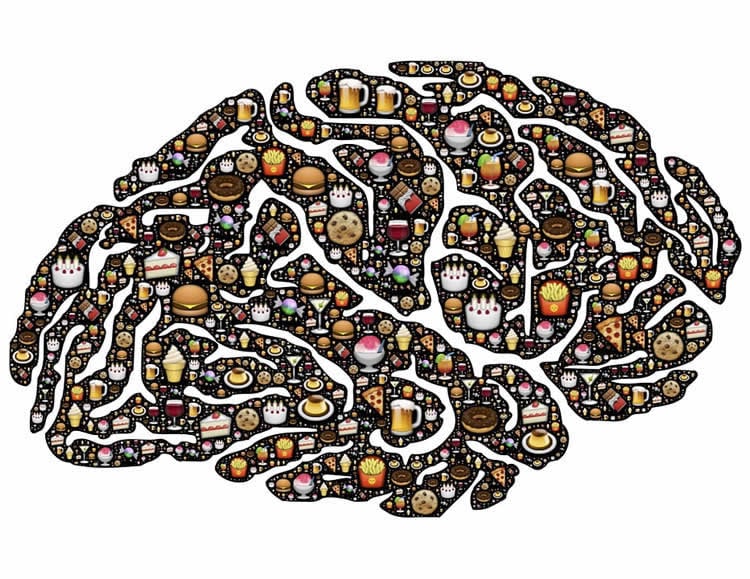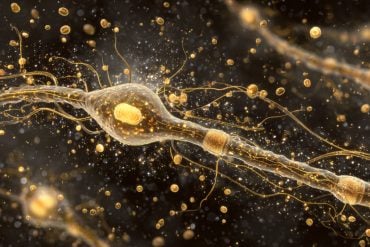Summary: According to researchers, high frequency dTMS increased beta endorphin levels, producing heightened feelings of reward following food ingestion. Researchers report this form of non-invasive brain stimulation could help alter food cravings in obese people.
Source: ECE.
Stimulating the brain to alter its intrinsic reward system shows promise in the treatment of obesity, according to results presented in Barcelona at the European Society of Endocrinology annual meeting, ECE 2018. The technique has yielded positive results after just a single treatment session, revealing its potential to become a safer alternative to treat obesity, avoiding invasive surgery and drug side effects.
Obesity is a global epidemic, with approximately 650 million adults and 340 million children and adolescents currently considered obese, and the disease contributing to an estimated 2.8 million deaths per year worldwide. It has been reported that, in some obesity cases, the reward system in the brain may be altered, causing a greater reward response to food than in normal weight individuals. This can make patients more vulnerable to craving, and can lead to weight gain. This dysfunction in the reward system can also be seen in cases of addiction to substances, e.g. drugs or alcohol, or behaviours, e.g. gambling.
Deep Transcranial Magnetic Stimulation (dTMS) is a medical treatment that uses magnetic energy to stimulate neurons in specific areas of the brain. It is used to treat depression and addictive behaviours, and previous studies have suggested that dTMS could be a good option to reduce drug and food cravings. However, the potential mechanism driving these changes had not been investigated until now.
In this study, Professor Livio Luzi and colleagues, from the Istituto di Ricovero e Cura a Carattere Scientifico Policlinico San Donato, Italy, investigated the effects of dTMS on appetite and satiety in obese people. They studied the effects of a single 30 minute session of dTMS, at high or low frequency, on blood markers potentially associated with food reward in a group of 40 obese patients. They found that high frequency dTMS significantly increased blood levels of beta-endorphins – neurotransmitters involved in producing heightened feelings of reward after food ingestion – compared to low frequency dTMS or controls.
“For the first time, this study is able to suggest an explanation of how dTMS could alter food cravings in obese subjects” says Professor Luzi. “We also found that some blood markers potentially associated with food reward, for example glucose, vary according to gender, suggesting male/female differences in how vulnerable patients are to food cravings, and their ability to lose weight.”

Since the current study only measures changes in blood markers, the next steps for the research group include using brain imaging studies to directly identify how high frequency dTMS changes the structure and function of the obese brain, both short and long term, and extending this treatment to a larger population of obese patients.
“Given the distressing effects of obesity in patients, and the socioeconomic burden of the condition, it is increasingly urgent to identify new strategies to counteract the current obesity trends. dTMS could present a much safer and cheaper alternative to treat obesity compared to drugs or surgery”, Professor Luzi adds.
Funding: The study was supported by the National Institutes of Health (ES007069, ES000002, ES009089, CA176726), and the Escher Fund for Autism.
Co-authors are Brent Coull, Harvard T.H. Chan School of Public Health; Éilis O’Reilly, School of Public Health and Epidemiology, University College Cork, Ireland; and Alberto Ascherio, Harvard T.H. Chan School of Public Health, and Brigham and Women’s Hospital, Boston.
Source: Stephanie Berger – ECE
Publisher: Organized by NeuroscienceNews.com.
Image Source: NeuroscienceNews.com image is in the public domain.
Original Research: The study “DEEP TRANSCRANIAL MAGNETIC STIMULATION ACUTELY MODULATES NEURO-ENDOCRINE PATHWAYS UNDERLYING OBESITY” by Anna Ferrulli, Michela Adamo, Stefano Massarini, and Livio Luziin will be presented at ECE 2018 – European Congress of Endocrinology.
[cbtabs][cbtab title=”MLA”]ECE “Brain Stimulation May Reduce Food Cravings as Obesity Treatment.” NeuroscienceNews. NeuroscienceNews, 21 May 2018.
<https://neurosciencenews.com/obesity-brain-stimulation-9095/>.[/cbtab][cbtab title=”APA”]ECE (2018, May 21). Brain Stimulation May Reduce Food Cravings as Obesity Treatment. NeuroscienceNews. Retrieved May 21, 2018 from https://neurosciencenews.com/obesity-brain-stimulation-9095/[/cbtab][cbtab title=”Chicago”]ECE “Brain Stimulation May Reduce Food Cravings as Obesity Treatment.” https://neurosciencenews.com/obesity-brain-stimulation-9095/ (accessed May 21, 2018).[/cbtab][/cbtabs]
Abstract
DEEP TRANSCRANIAL MAGNETIC STIMULATION ACUTELY MODULATES NEURO-ENDOCRINE PATHWAYS UNDERLYING OBESITY
Deep Transcranical Magnetic Stimulation (dTMS) is a non-invasive modulation technique of cortical excitability that has shown to affect the mesolimbic and mesostriatal dopaminergic pathways. Consistent with these assets, dTMS is widely used as a therapeutic tool in neuro-psychiatric disorders associated with abnormal cortical excitability and dopaminergic activity, as addiction. Hence, considering the dysfuncional role of PFC and dopaminergic reward system in controlling appetite, dTMS was suggested to be affective in reducing food craving and in controlling body weight in obese subjects. However, the underlying physiological mechanisms of the dTMS effects are not fully know. Aim of this study was to investigate the effects of a single dTMS session on neuro-endocrine pathways in obesity.
Fourty obese patients (11 M, 29 M; age: 48.0±1.6; BMI: 36.3±0.7) were assigned to receive one session of high frequency (18 Hz, HF), low frequency (1 Hz, LF) or Sham stimulation via an H-coil dTMS. H-coil was targeted to stimulate Prefrontal Cortex and Insula, bilaterally. Metabolic and neuro-endocrine parameters were evaluated before and after a single dTMS session.
Following the 18 Hz dTMS session, a significant increase of norepinephrine was found (5.6±0.9 vs 6.5±1.2 ng/mL, +18.0±6.8%, p=0.01; p=0.05 vs LF); a rise in β-endorphins levels was also shown (0.338±0.049 vs 0.372±0.048 ng/mL, +13.9±4.6%, p=0.017; p=0.010 vs Sham; p=0.011 vs LF). In the same group, glucose levels significantly increased (90.2±4.1 vs 96.2±4.2 mg/dL, +7.0±1.8%, p=0.002), whilst leptin levels significantly decreased (66.9±10.5 vs 56.3±9.0 ng/mL, -16.3±3.0%, p=0.002). Furthermore, pituitary hormones significantly decreased after a single 18 Hz dTMS session, specifically TSH (2.71±0.25 vs 2.09±0.18 μU/mL, -20.7±4.7%, p=0.001) and prolactin (17.1±1.3 vs 10.6±0.8 ng/mL, -34.7±4.7%, p<0.0001). In the LF, a significant reduction of salivary cortisol was also observed (-29.4±9.3%, p=0.015). These results suggest that dTMS can acutely affect orexygenic pathways and metabolic parameters mainly via modulation of the sympathetic activity and hypothalamic-pituitary-adrenal axis. The increase of β-endorphins could suggest a potential role of HF dTMS in inducing the dopaminergic system activation and therefore, in modulating the food reward system. Together these findings support the role of dTMS as a novel promising treatment for obesity. [divider]Feel free to share this Neuroscience News.[/divider]






